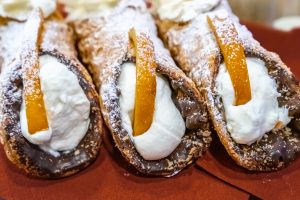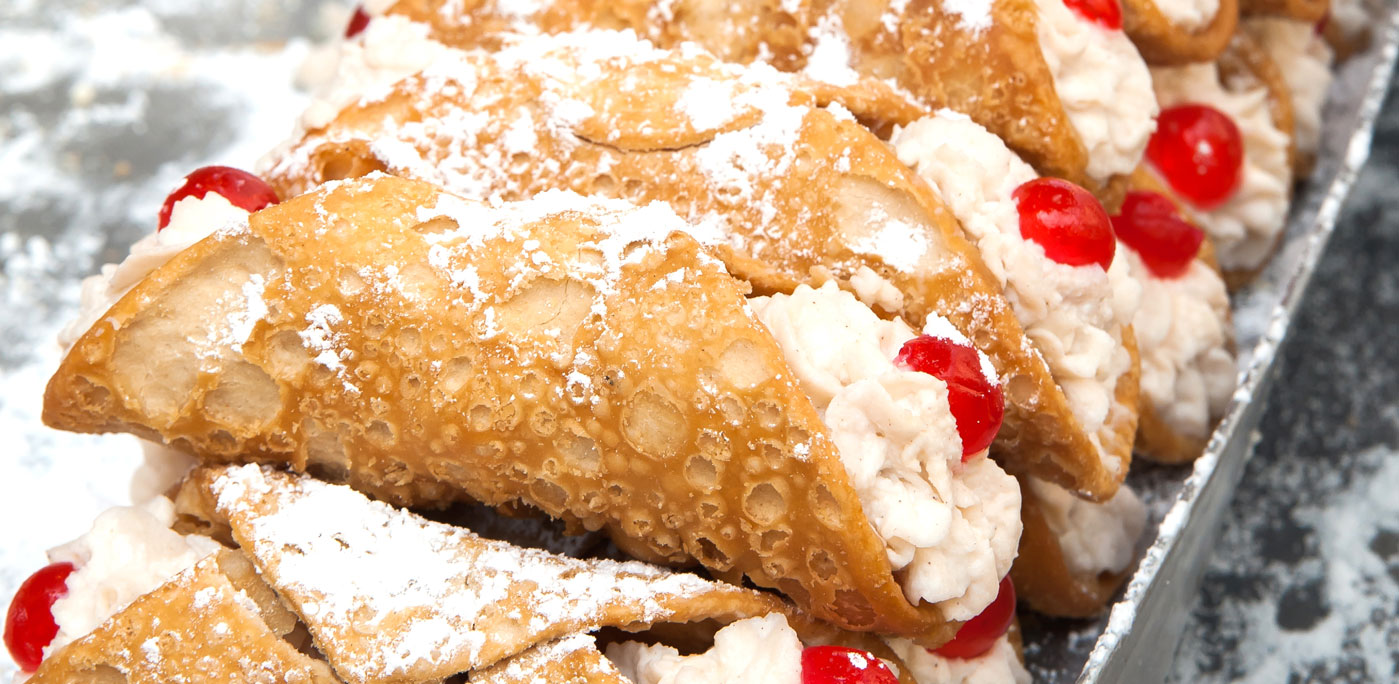Cannolo siciliano: is there any other Italian dessert this popular in the world? Tiramisù may be one of its more glorious competitors, but cannolo making is an art that you can’t reproduced at home with the same simplicity. We can all make a good tiramisù in our own kitchen, but preparing cannoli right is far from an easy task.
Cannoli siciliani have also a huge identity-defining power: Italian bakeries all over the world make of their presence on the shelves a symbol of “italianità” and heritage associated with only a handful of other products.
And then, cannoli are delicious in a decadent, rich sweetness-that-melts-in-the-mouth way: the creamy, slightly tangy flavor of ricotta is mellowed by the sweet delicacy of sugar and chocolate and by the exotic fragrance of candied fruits, the crunchiness of their fried, light shell bringing out this amazing symphony of flavors and textures.
Cannoli, traditional and ancient, are what make or break bakers: in Sicily, the quality and standards of your bakery can be judged on the basis of how good your cannoli are, and this is not at all that surprising considering how profound is the tie between the delicious cannolo and its beautiful fatherland. The history of cannoli siciliani is mirror to the variety of cultures and people that, throughout the centuries, have inhabited Sicily and called it home and, just as it happens for so many sicilian dishes, several culinary influences may be identified in every bite.
Two are the legends telling us the origin of cannoli, both of them agreeing on one thing: women are behind their creation, which took place in – or around – the town of Caltanissetta.
The first tale brings us into an Arab prince’s harem, during the Arabic domination of the island. It seems that here, the emir’s many concubines spent their time creating luscious meals and dishes for their lover: among them, a cylinder-shape pastry case filled with ricotta, almonds and honey. Apparently, the pastry’s shape was chosen to honor… the emir’s own physical prowess…
Supporting the arab origin of cannoli is the fact that the city of Caltanissetta is historically tied to the presence of the Moors in Sicily, as attested by its very name, which derives from “kalt el nissa,” an arabic locution meaning “women’s castle.” Interesting, considering the legend is set in a castle and the invention of cannoli, according to it, lies in the skillful hands of women.
Similar is the other theory associated with the creation of the first cannolo : we’re always around Caltanissetta, but this time not in the city and not in a castle, but in a convent in its proximity. Here, this other legend recounts, nuns concocted a new type of pastry made of a shell, called “scorcia,” and a filling of ricotta, sugar, chocolate and almonds to celebrate Carnevale.
Concubines or nuns, it’s certain that cannoli were first made at the time of Sicily’s Arab domination, between 827 and 1091, and that many of the ingredients used were, in fact of Arab origin: it was the Arabs that brought to Sicily sugar cane, rice, almonds, jasmine, aniseed, sesame, saffron and cinnamon, all ingredients heavily present in Sicilian cuisine still today. It is also well known that another quintessentially Sicilian dessert, cassata, has demonstrated Arab roots. Sheep ricotta was already a food staple on the island prior to Arab dominance, however, it was them, savvy bakers and sweet things connoisseurs, to mix it with sugar, creating the crucial ingredient not only of cannoli, but also of cassata.

Historians believe both legends carry a seed of truth: when the Normans conquered Sicily, ending a two century long Arab domination, many of the women who once inhabited the emir’s harem were freed and sought refuge in convents. Many of them decided to stay and became nuns. Here, they may have used in the kitchen some of the culinary skills they had learnt at the emir’s court.
And when you think the mystery has been finally cleared, here come the ancient Romans: Cicero, in the first century before Christ, already mentions the existence in Sicily of a tubus farinarius, dulcissimo, edulio ex lacte facto (“a flour based, cylindre shaped pastry made with milk, that makes the sweetest of foods”), very similar, it seems, to cannoli.
As long as culinary literature is concerned, the origins of cannoli were discussed for the first time by duke Alberto Denti di Pirajno, author of Siciliani a Tavola (“Sicilians at their table”), who believed the nuns, although certainly influenced by Arab cuisine, invented them.
As it often happens, the truth about cannoli’s historical origins is probably a mix of all the legends and beliefs collected and passed on through the centuries: a form of cannolo may have been already present in Roman times, but evolved into what we know and love today thanks to the fusion of Sicilian and Arab culinary practices, as elaborated in convents where, especially in the Middle Ages, many a delicacy were invented. Interesting as it may be, knowing exactly where cannoli come from is not essential to us, today, to appreciate how good they are.



























